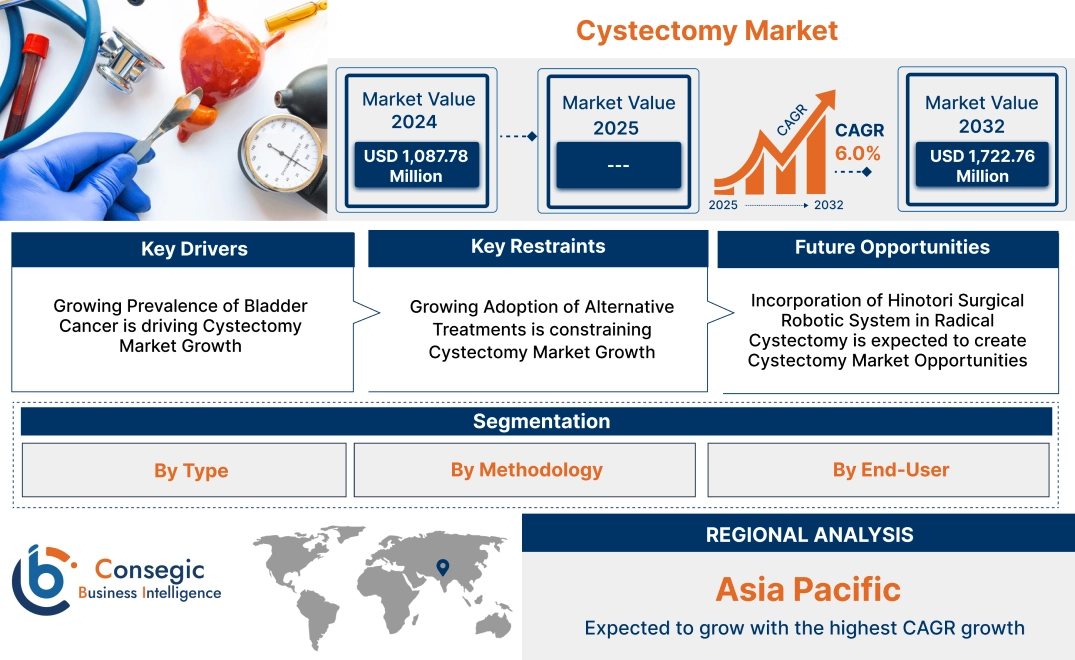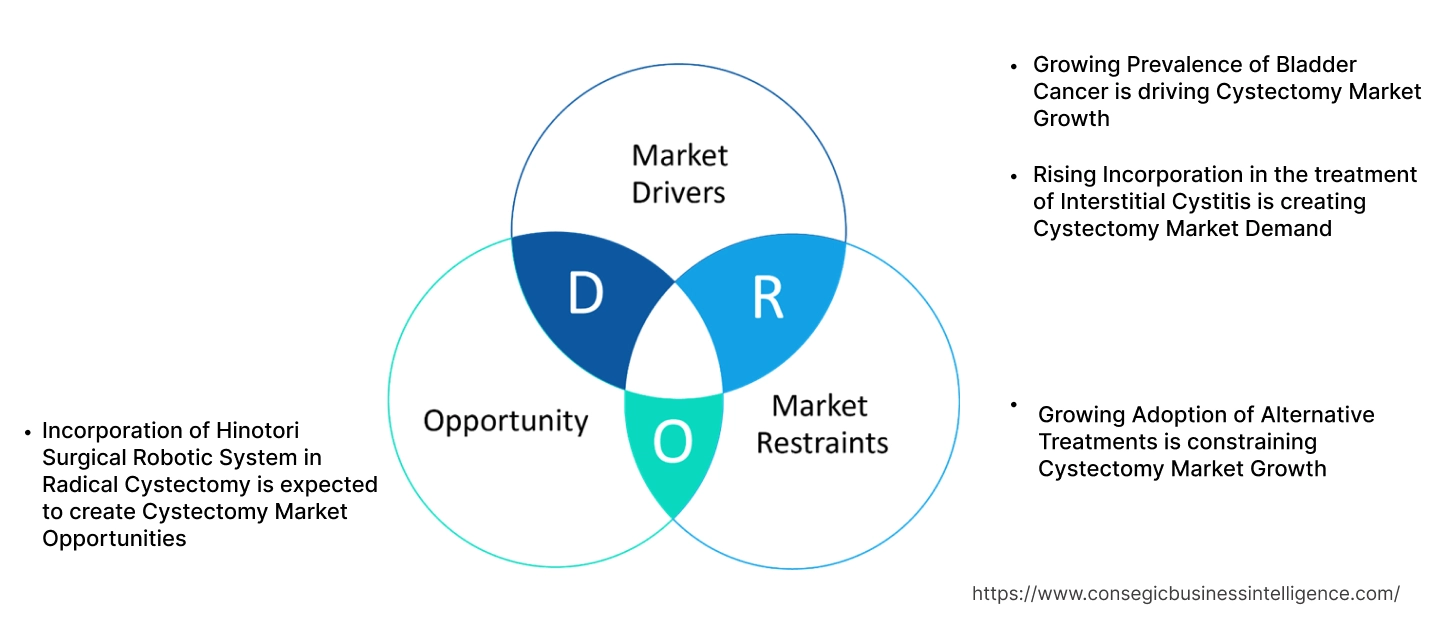- Summary
- Table Of Content
- Methodology
Cystectomy Market Size:
Cystectomy market size is estimated to reach over USD 1,722.76 Million by 2032 from a value of USD 1,087.78 Million in 2024, growing at a CAGR of 6.0% from 2025 to 2032.
Cystectomy Market Scope & Overview:
Cystectomy is a surgical procedure which involves the partial or complete removal of bladder. It is classified into three types as radical, simple, and partial. In cystectomy, surgeon removes the entire urinary bladder along with nearby lymph nodes and surrounding organs such as prostate in men and uterus in women. It is performed through open surgery, minimally invasive surgery and robotic surgery. Cystectomy offers several advantages such as minimal invasive option, effective treatment for bladder cancer, improved quality of life and shorter hospital stays, further driving the cystectomy market expansion. Recent incorporation of robotic surgical system in cysstromy is enhancing precision, surgical accessibility and patient recovery times.
Key Drivers:
Growing Prevalence of Bladder Cancer is driving Cystectomy Market Growth
Bladder cancer is type of cancer that forms in the tissues of the bladder. The cystectomy which involves the entire removal of urinary bladder is widely used in the treatment of bladder cancer to remove cancerous tissues. The prevalence of bladder cancer is rising due to several factors such as aging population, tobacco use, chronic bladder infections and changing lifestyle, further driving the market.
- In 2022, according to Global Cancer Observatory, 614,298 people were diagnosed with bladder cancer in 2022 globally, representing 7.1% increase from the year 2020. The cystectomy is surgical procedure used in the treatment of bladder cancer to prevent it from spreading and eliminating cancerous tissues. It is typically followed by reconstruction surgery to restore urinary function.
Thus, rising prevalence of bladder cancer is leading to cystectomy market demand to improve patient outcomes and survival rate.
Rising Incorporation in the treatment of Interstitial Cystitis is creating Cystectomy Market Demand
Interstitial cystitis is a chronic medical condition that causes persistent bladder pain, discomfort and urinary urgency. The cystectomy is widely used in the treatment of interstitial cystitis to eliminate the source of pain and inflammation, offering patients a better quality of life. The cases of interstitial cystitis is rising due to several factors such as poor diet, stress aging population and chronic health conditions, further driving the market.
- In 2022, according to Continence journal, about 300 per 100,000 women are diagnosed with interstitial cystitis globally. The cystectomy is a surgical procedure used in the treatment of interstitial cystitis to remove partial or entire urinary bladder to elevate symptoms and improving quality of life in patients.
Thus, rising incorporation of cystectomy in the treatment of interstitial cystitis is leading to cystectomy market expansion by reducing pain and improving quality of life in patients.
Key Restraints:
Growing Adoption of Alternative Treatments is constraining Cystectomy Market Growth
Alternative treatments like transurethral resection of bladder tumor, chemotherapy and immunotherapy are increasingly preferred for bladder cancer as they avoid the risks and recovery time associated with cystectomy. These treatments are effective in managing non-muscle invasive bladder cancer, leading to lower demand for cystectomy procedure, especially among patients who seek bladder preservation. Further, immunotherapy with Bacillus Calmette-Guerin treatments is highly preferred by patients due to its lower risk and personalized treatment approach. Additionally, advancement in bladder sparing surgery and radiation therapy with similar patient outcomes, further reduces the reliance on cystectomy in the bladder cancer treatment.
Thus, rising adoption of alternative treatments like chemotherapy, immunotherapy and others is constraining the market supported by lower risks and less recovery time.
Future Opportunities :
Incorporation of Hinotori Surgical Robotic System in Radical Cystectomy is expected to create Cystectomy Market Opportunities
The hinotori surgical robotic system is an advanced robotic platform designed to assist surgeons in performing minimally invasive procedures with enhanced precision, control and flexibility. It comprises of three units: an operation unit, a surgical cockpit, and a vision unit along with anti-shake mechanism controlled by a computer system. Incorporation of surgical robotic system in cystectomy enhances dexterity in surgery with its robotic arms, 3D visualizations and easier navigation through complex anatomical structures with high precision.
- In 2024, according to Tranlational Cancer Research, robot-assisted radical cystectomy is performed in patient using hinotori surgical robotic system. It improves perioperative outcomes with less blood loss and lower blood transfusion in patient.
Thus, incorporation of hinotori surgical robotic system is expected to create cystectomy market opportunities supported by high precision and quicker recovery times.
Cystectomy Market Segmental Analysis :
By Type:
By type, the market is divided into radical, simple, and partial cystectomy.
Trends in Type:
- According to cystectomy market trends, radical cystectomy is widely used to entirely remove urinary bladder in bladder cancer patients.
- Adoption of partial cystectomy is rising to preserve the bladder function and eliminating cancerous tissues as per market trends.
The radical cystectomy accounted for the largest market share in the year 2024.
- Radical cystectomy refers to the surgical removal of entire urinary bladder along with surrounding tissues such as prostate in men and uterus in women.
- This procedure is accompanied by urinary diversion techniques such as the creation of neobladder or an ileal conduit to reroute urinary flow.
- Radical cystectomy is typically performed to treat muscle invasive bladder cancer(MINC) or high-risk non muscle invasive bladder cancer(NMIBC).
- Further, rising cases of non-muscle invasive bladder cancer patients is driving the demand for this procedure.
- For instance, in 2023, according to the Journal of Urology, NMIBC represents approximately 75% of the 82,000 estimated new bladder cancer cases diagnosed in the United States. Radical cystectomy is used in the treatment of NMIBC, ensuring entire removal of cancerous tissues further enhancing patient outcomes.
- Thus, radical cystectomy is widely used surgical procedure to improve patient outcomes and survival rate by removing entire cancerous tissues.
The partial cystectomy is expected to grow at the fastest CAGR over the forecast period.
- Partial cystectomy is a surgical procedure used to treat bladder cancer by removing only the part of the bladder affected by the tumor, rather than the entire bladder.
- The goal of partial cystectomy is to eliminate the cancer while preserving as much bladder function as possible.
- It is often followed by additional treatments, such as chemotherapy or radiation, to reduce the risk of recurrence.
- Incorporation of partial cystectomy is growing among the bladder cancer patients due to its several advantages such as minimal surgical trauma, no need for urinary diversion and preservation of sexual function.
- Thus, use of partial cystectomy is growing significantly due to minimal surgical trauma and preservation of bladder function in patients.
By Methodology:
By methodology, the market is divided into open surgery, minimally invasive surgery and robotic surgery.
Trends in Methodology:
- According to cystectomy market trends, minimal invasive surgery is widely used due to fewer complications and less complexity.
- Incorporation of robotic surgery is expanding supported by high precision and improved clinical outcomes as per market trends.
The minimal invasive surgery accounted for the largest market share in the year 2024.
- Minimal invasive surgery in cystectomy refers to smaller incision, specialized tools and advanced technologies like laparoscopy to remove urinary bladder.
- This methodology involves minimal disruption to the surrounding tissues, resulting in quicker recovery compared to traditional opens surgery.
- In minimal invasive surgery, surgeon access the urinary bladder though small cut or incision without cutting the large part.
- The use of minimal invasive surgery is dominating in cystectomy due to its several advantages like reduced blood loss, shorter hospital stays and faster recovery times.
- Thus, minimal invasive surgery is widely used methodology in the market due to advanced technology and quicker recovery in the patients.
The robotic surgery is expected to grow at the fastest CAGR over the forecast period.
- Robotic surgery in cystectomy is a surgical procedure where a robotic system such as da Vinci surgical system is used for high precision.
- It enhances surgeon’s capabilities by providing improved visualizations, greater accessibility, and more controlled movements along with reduced blood loss, faster recover times and minimal scarring for the patients.
- Due to several advantages, hospital are widely incorporating robotic cystectomy to improve patient outcomes and surgical capabilities.
- For instance, in 2024, Mount Sinai hospital performed 500th robotic cystectomy under Mount Sinai's Bladder Cancer Program in the United States. It allows patients to have a quicker recovery with less blood loss and less pain.
- Thus, incorporation of robotic surgery is rising due to its high precision and improved patient outcomes.
By End-User:
By end-user, the market is divided into hospitals and clinics, urology centers, and others.
Trends in End-User:
- As per market trends, hospitals and clinics are widely incorporating cystectomy to treat bladder cancer patients.
- Urology centers are increasingly adopting cystectomy supported by modern healthcare facilities and advanced equipment as per market trends.
The hospitals and clinics accounted for the largest market share of 58.53% in the year 2024.
- Hospitals and clinics are widely performing cystectomy due to their comprehensive infrastructure, skilled workforce and access to advanced surgical technologies.
- These facilities are well equipped with advanced operating rooms and intensive care units ensuring high quality preoperative and postoperative care in the surgical procedures.
- Hospitals and clinics handle large volume of bladder cancer cases, making them primary option for cystectomy procedures such as radical, partial and robotic-assisted surgeries.
- Furthermore, the expanding hospital market in countries contributes to the growing demand for cystectomy.
- For instance, in 2024, according to India Brand Equity Foundation, the hospital market in India projected to grow at 8.0% from 2024 to 2032.
- Thus, hospitals are clinics are widely incorporating cystectomy supported by advanced operating rooms and skilled workforce.
The urology centers is expected to grow at the fastest CAGR over the forecast period.
- Urological centers are specialized medical facilities, focused on the diagnosis, management and treatment of urinary tract conditions as well as male reproductive health.
- In the cystectomy market, urological centers are significantly incorporating radical and partial cystectomy which are essential in the treatment of bladder cancer.
- These centers are well-equipped with advanced equipment like robotic system to improve surgical outcomes and mortality.
- Urological centers also plays important role in postoperative patient care such as bladder reconstruction and patient rehabilitation.
- Thus, urology centers are emerging rapidly in the market due to its advanced facilities, diagnosis and management of urology conditions such as bladder cancer.
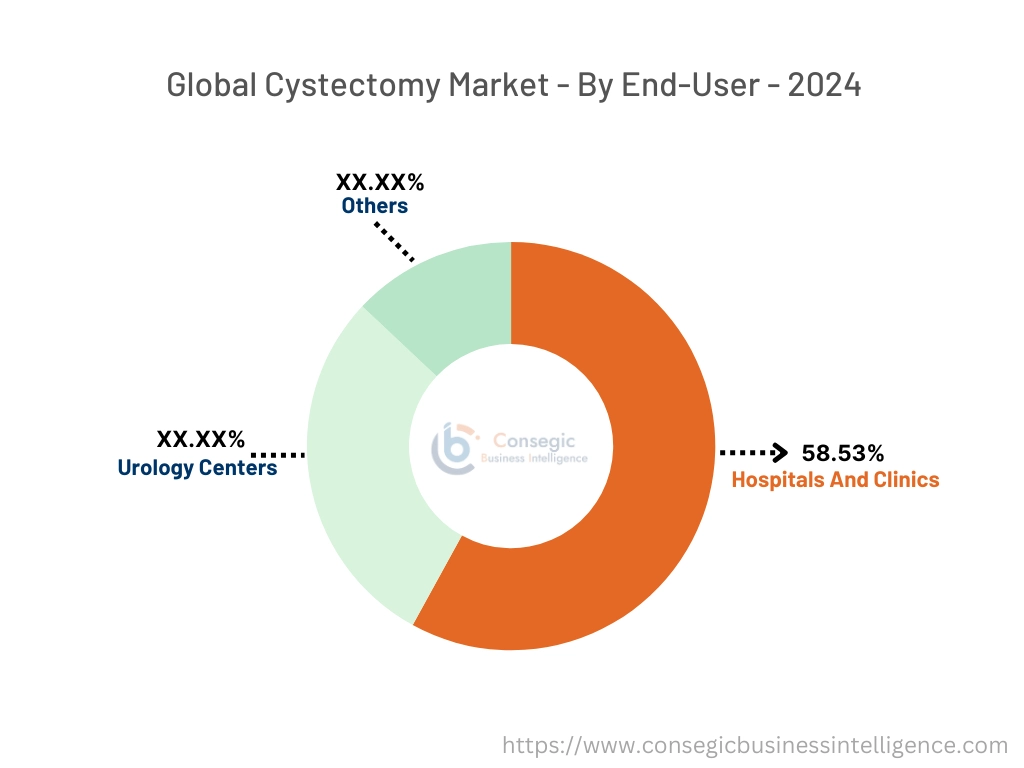
Regional Analysis:
The regional segment includes North America, Europe, Asia Pacific, the Middle East and Africa, and Latin America.
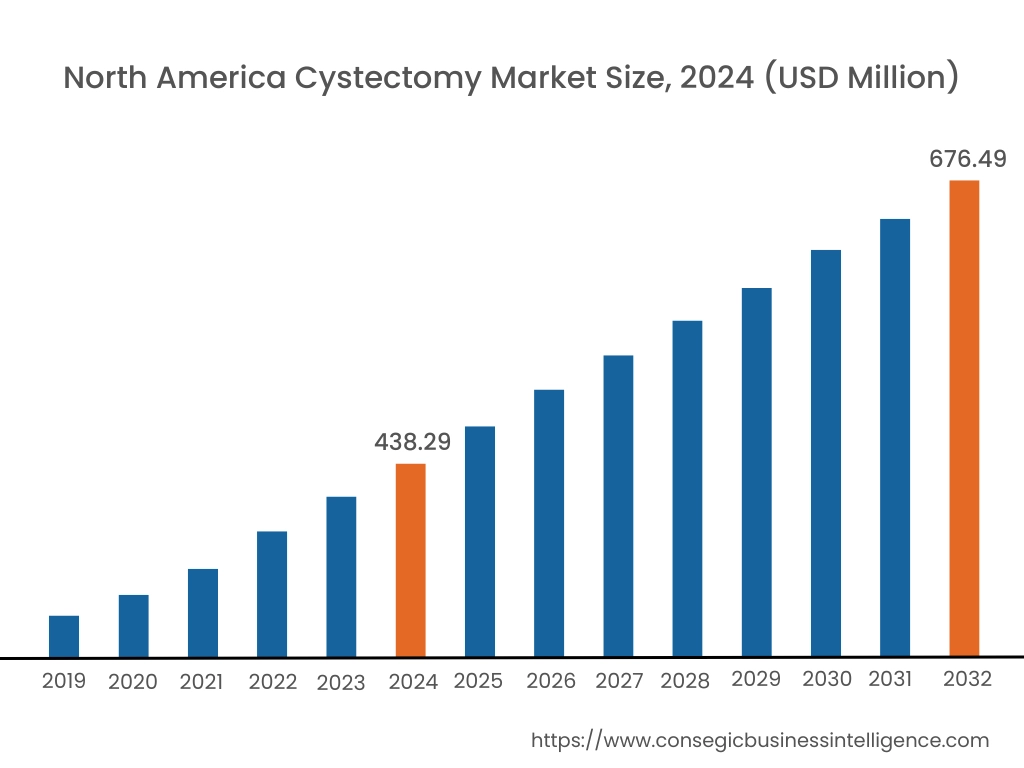
In 2024, North America accounted for the highest market share at 40.3% and was valued at USD 438.29 Million and is expected to reach USD 676.49 Million in 2032. In North America, United States accounted for the highest market share of 71.79% during the base year of 2024. The cystectomy market share of North America is significant, due to rising well-established healthcare infrastructure and rising number of cancer hospitals. The region is also leading in terms of advanced machinery and government funding for cancer research and developments. The cancer hospitals in the region are increasingly adopting robotic assisted surgeries for cystectomy thereby reducing mortality and improving patient outcomes. Further, the favorable reimbursement policies and growing prevalence of bladder cancer is boosting the market in the region.
- In 2022, according to American Cancer Society, an estimated 81,180 new cases of bladder cancer diagnosed in the US. The cystectomy is a surgical procedure which is widely used in the treatment of bladder cancer to remove cancerous tissues and to prevent further spreading of cancer in the patients.
Thus, North America is leading in the market due to favorable reimbursement policies and rising number of cancer hospitals as per analysis.
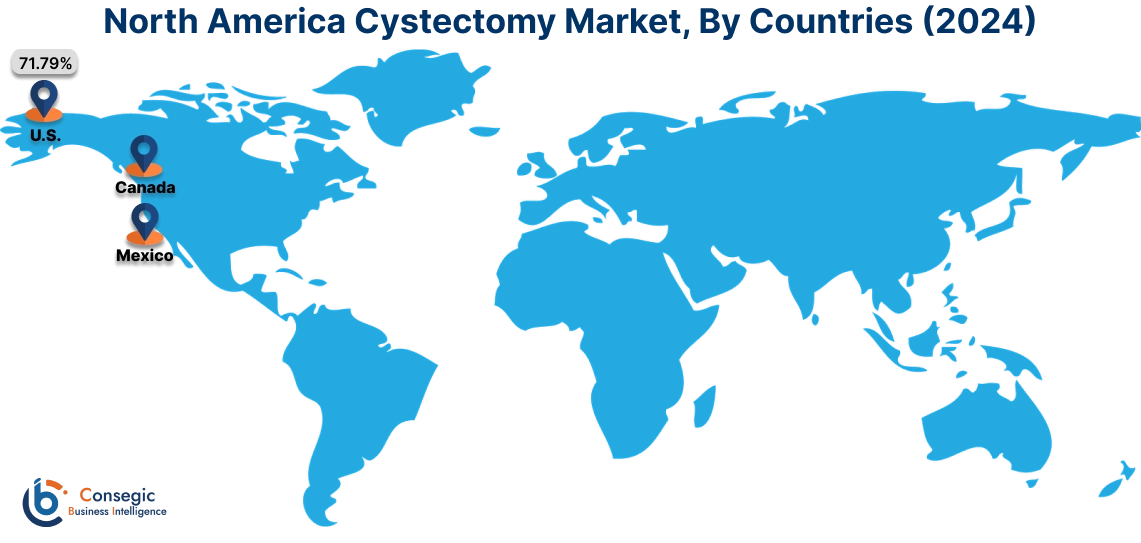
Asia-pacific is expected to witness the fastest CAGR of 6.8% over the forecast period of during 2025-2032. As per cystectomy market analysis, Asia-Pacific region is experiencing significant growth driven by increasing prevalence of bladder cancer, early diagnosis, advancement in biotechnology and rising healthcare spending. Adoption of cystectomy is rising, especially in countries like China, India, Japan and South Korea, which are leading in research and development. The government in this region is investing heavily in robotic surgeries to improve mortality rates and surgical outcomes. Additionally, the advancement in cancer treatment and improved accessibility in both rural and urban areas is expanding the market. The region is also growing in terms of urology centers which are providing advanced facilities, diagnosis and management of urology conditions.
Thus, cystectomy market share of Asia-Pacific is expanding due to rising prevalence of bladder cancer and improved healthcare infrastructure as per market analysis.
The market in Europe is experiencing steady growth, driven by rising prevalence of bladder cancer and other urological conditions, along with advancements in surgical technologies. The increasing demand for minimally invasive procedures, including robotic-assisted cystectomy is expanding the market, particularly in countries like Germany, United Kingdom and France. Europe’s well established healthcare infrastructure and high adoption rate of robotic system is driving the market in the region. The demand for partial and radical cystectomy is particularly high due to aging population and rising presence of bladder cancer. Moreover, growing emphasis on patient outcomes such as reduced recovery times and fewer complications, is further boosting the market as per analysis.
In Middle East and Africa, the market is steadily growing due to rising prevalence of bladder cancer, increasing healthcare investment, government support and advancement in healthcare infrastructure. The cystectomy treatment is gradually becoming available, primarily in nations like Dubai, UAE and Saudi Arabia where advanced hospitals and government organizations provide access to minimally invasive techniques. The patients in this region prefer robotic assisted surgery to improve survival rate and clinical outcomes. The region is also well-established in terms of medical tourism, where patients are coming for advanced cancer treatment. Moreover, advancements in robotic surgery and growing urology centers is further driving the market growth in the region as per analysis.
As per cystectomy market analysis, Latin America is experiencing steady growth, driven by increasing awareness of minimal surgical techniques and rising prevalence of bladder cancer in the older patients. The healthcare facilities in the region are largely adopting radical and partial cystectomy in the treatments of patients with bladder cancer. Countries like Brazil, Mexico and Argentina are the major contributors in the market due to improved healthcare infrastructure and growing adoption of advanced cancer care technologies. Governments and healthcare organizations are making significant efforts to enhance cancer care through funding and partnerships with global pharmaceutical companies. However, challenges like limited availability of cancer care specialists, and higher cost is restraining the industry growth in the Latin America.
Top Key Players and Market Share Insights:
The cystectomy industry is highly competitive with major players providing services to the national and international markets. Key players are adopting several strategies in research and development (R&D) and product innovation to hold a strong position in the global cystectomy market. Key players in the cystectomy industry include-
- Zephyr Surgical Implants (Switzerland)
- Intuitive Surgical (United States)
- Verb Surgical (United States)
- Roswell Park Comprehensive Cancer Center (United States)
- Brigham and Women's Hospital (United States)
- Asensus Surgical US, Inc (United States)
- Mayo Foundation for Medical Education and Research (United States)
- Advanced Health Care Resources (United States)
- Titan Medical Inc. (Canada)
- Boston Scientific Corporation (United States)
Recent Industry Developments :
Business Investment:
- In 2022, Paul hospital invested USD 1.5 Million for the purchase of da Vinci Surgical System under St. Paul's Hospital Foundation capital campaign. It is used for performing procedures such as prostatectomy, cystectomy and others, improving healing and recovery times in patients.
Cystectomy Market Report Insights :
| Report Attributes | Report Details |
| Study Timeline | 2019-2032 |
| Market Size in 2032 | USD 1,722.76 Million |
| CAGR (2025-2032) | 6.0% |
| By Type |
|
| By Methodology |
|
| By End-User |
|
| By Region |
|
| Key Players |
|
| North America | U.S. Canada Mexico |
| Europe | U.K. Germany France Spain Italy Russia Benelux Rest of Europe |
| APAC | China South Korea Japan India Australia ASEAN Rest of Asia-Pacific |
| Middle East and Africa | GCC Turkey South Africa Rest of MEA |
| LATAM | Brazil Argentina Chile Rest of LATAM |
| Report Coverage |
|
Key Questions Answered in the Report
How big is the cystectomy market? +
In 2024, the cystectomy market is USD 1,087.78 Million.
Which is the fastest-growing region in the cystectomy market? +
Asia-pacific is the fastest-growing region in the cystectomy market.
What specific segmentation details are covered in the cystectomy market? +
Type, methodology, and end-user are covered in the cystectomy market.
Who are the major players in the cystectomy market? +
Zephyr Surgical Implants (Switzerland), Intuitive Surgical (United States) and Asensus Surgical US, Inc (United States).
